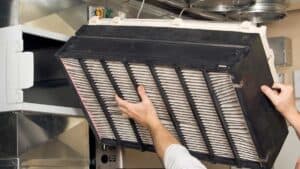Is your AC unit not working at its optimal capacity? A clogged drain line could be the culprit behind those unsatisfactory cooling results. But don’t panic! With our step-by-step guide, you’ll learn how to clear a clogged AC drain line like a pro and prevent costly repairs.
In this comprehensive article, we’ll walk you through the process from start to finish, ensuring you have all the information and techniques you need to tackle this common issue. You’ll discover how to identify a clogged drain line, the tools required for the job, and the correct method to clear the blockage.
By following our guide, you can save money on potential repair costs and keep your AC system running smoothly year-round. Plus, with the bonus tips we provide, you’ll also learn how to maintain a clear drain line in the future, ensuring a longer lifespan for your unit.
Say goodbye to a clogged AC drain line and hello to a cool and comfortable home. Let’s get started on tackling this issue together!
Understanding the importance of a clear AC drain line
A clear AC drain line is vital for the proper functioning of your air conditioning system. The drain line is responsible for removing the condensation that occurs when warm air passes over the cold evaporator coils. If the drain line becomes clogged, water can back up into your AC unit, causing damage and reducing its efficiency.
When the drain line is blocked, the excess water can overflow, leading to water damage in your home or even potential mold growth. Additionally, a clogged drain line can hinder the unit’s ability to dehumidify the air, resulting in a less comfortable indoor environment.
Regular maintenance and clearing of the AC drain line are crucial to prevent these issues and ensure the longevity of your AC system. Now that you understand the importance of a clear drain line, let’s move on to recognizing the signs of a clogged AC drain line.
Signs of a clogged AC drain line
Identifying a clogged AC drain line early on can help prevent further damage and expensive repairs. Here are some signs to look out for:
- Water leakage: If you notice water pooling around your AC unit or dripping from the indoor unit, it is a strong indication of a clogged drain line. The water may appear near the indoor unit or even in the ceiling or walls.
- Musty odor: A clogged drain line can cause stagnant water to accumulate in the AC system, leading to a musty odor in your home. If you notice a foul smell when your AC is running, it’s likely due to a clogged drain line.
- Reduced cooling efficiency: A clogged drain line can interfere with the proper functioning of your AC system, resulting in reduced cooling performance. If you find that your AC is not cooling your home as effectively as before, it’s worth checking the drain line for any blockages.
Now that you know what to look for, let’s gather the tools and materials required to clear a clogged AC drain line.
Tools and materials needed for clearing a clogged AC drain line
Before you begin the process of clearing a clogged AC drain line, make sure you have the following tools and materials on hand:
- Wet/dry vacuum: A wet/dry vacuum is an essential tool for removing debris and blockages from the AC drain line. Make sure it has enough suction power to effectively clear the line.
- A mixture of vinegar and water: Vinegar is a natural cleaning agent that can help dissolve any organic matter or buildup in the drain line. Mix equal parts of vinegar and water in a container to create a cleaning solution.
- Safety goggles and gloves: It’s important to protect yourself while working on your AC system. Safety goggles will shield your eyes from any debris or splashes, and gloves will keep your hands clean and safe.
Now that you have all the necessary tools, let’s dive into the step-by-step process of clearing a clogged AC drain line.
Step 1: Shutting off the power to the AC unit
Before starting any work on your AC system, it’s crucial to ensure your safety by turning off the power. Locate the AC unit’s electrical disconnect switch, usually located near the outdoor unit. Flip the switch to the “off” position to cut off power to the unit. This step is essential to prevent any accidents or electrical shocks while working on the drain line.
Step 2: Locating the AC drain line
The AC drain line is typically a PVC pipe that runs from the indoor unit to the outside of your home. Look for a white, plastic pipe near the indoor unit. It is usually connected to a drain pan. Once you’ve located the drain line, you’re ready to proceed to the next step.
Step 3: Clearing the AC drain line using a wet/dry vacuum
Now it’s time to clear the clogged drain line using a wet/dry vacuum. Attach the vacuum hose to the end of the drain line, ensuring a secure connection. Turn on the vacuum and let it run for a few minutes. The suction from the vacuum will help remove any debris or blockages from the drain line.
Continue running the vacuum until you no longer hear any suction or see any debris being pulled out. This indicates that the drain line is clear. If the clog persists, you may need to repeat the process or try alternative methods.
Step 4: Flushing the AC drain line with a mixture of vinegar and water
Once the drain line is clear of debris, it’s time to flush it with a mixture of vinegar and water. This will help remove any remaining buildup or residue inside the drain line. Take the container with the vinegar and water mixture and pour it into the drain line. Allow the mixture to sit in the line for about 30 minutes to break down any remaining deposits.
After the designated time, flush the drain line with clean water. You can do this by pouring water directly into the drain line or using a hose connected to the outdoor end of the line. Continue flushing until the water runs clear, indicating that the drain line is free from any vinegar or debris.
Step 5: Testing the AC drain line for proper drainage
With the drain line cleared and flushed, it’s essential to test its functionality. Fill a cup with water and pour it into the AC drain pan. Observe the drainage from the drain line. The water should flow freely through the drain line, indicating that it is working properly.
If you notice any slow or restricted drainage, there may still be a partial blockage in the line. In such cases, you may need to repeat the clearing and flushing process or seek professional assistance.
Preventive measures to avoid future clogs in the AC drain line
Clearing a clogged AC drain line is just the first step in maintaining a properly functioning system. To avoid future clogs and expensive repairs, consider implementing the following preventive measures:
- Regular maintenance: Schedule regular maintenance for your AC system, including professional inspections and cleanings. A professional technician can identify potential issues before they escalate and ensure the drain line remains clear.
- Change air filters: Dirty air filters can contribute to clogged drain lines. Regularly change your AC’s air filters to prevent dust and debris from entering the system and potentially causing blockages.
- Keep the area around the indoor unit clean: Vacuum or dust the area around the indoor unit regularly to prevent debris from entering the system and clogging the drain line.
- Install a drain line cleaning device: Consider installing a drain line cleaning device, such as a drain pan float switch or a drain line blowout device. These devices can help prevent clogs by automatically clearing the drain line or alerting you to potential issues.
By following these preventive measures, you can reduce the likelihood of future clogs and maintain a smoothly functioning AC system.
Conclusion: Importance of regular maintenance for the AC system
A clogged AC drain line can lead to costly repairs, water damage, and reduced cooling efficiency. By understanding the importance of a clear drain line and following our step-by-step guide, you can effectively clear any clogs and prevent further issues.
Remember to regularly maintain your AC system, change air filters, and keep the area around the indoor unit clean to avoid future clogs. Implementing these preventive measures will help extend the lifespan of your AC unit and ensure a cool and comfortable home throughout the year.
Don’t let a clogged AC drain line disrupt your comfort. Take action today and enjoy the benefits of a properly functioning AC system.





